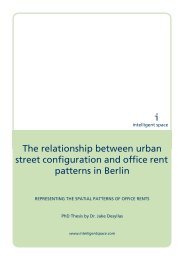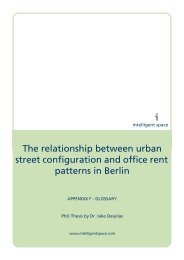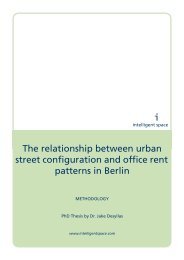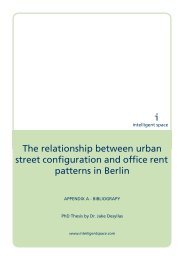Notting Hill Carnival Strategic Review - Intelligent Space
Notting Hill Carnival Strategic Review - Intelligent Space
Notting Hill Carnival Strategic Review - Intelligent Space
Create successful ePaper yourself
Turn your PDF publications into a flip-book with our unique Google optimized e-Paper software.
“A People’s Art is the Genesis of their Freedom” - Beginnings of <strong>Carnival</strong><br />
1.21 One such ‘space’ was provided by Claudia Jones, a leading member of the West Indian Workers<br />
and Students’ Association and a prominent figure in the black community. Jones was also the<br />
editor and co-founder of the West Indian Gazette, a news journal designed to address black<br />
issues and provide a source of inspiration, assurance and information to an embattled minority<br />
community. Following the 1958 disturbances, Jones cultivated the idea of establishing a carnival<br />
as a vehicle through which to uplift the Caribbean community, build upon the new found sense<br />
of unity and begin the process of healing. The primary purpose of the event was to “present<br />
West Indian talent to the public, which at that time could not see Caribbean people as anything<br />
other than hewers of wood and drawers of water”. The Gazette sponsored the creation of a<br />
Caribbean <strong>Carnival</strong> Committee and, as a positive reaction to the divisive events surrounding the<br />
riots, Jones used her skills and connections to bring together African, Caribbean and other artists<br />
and performers in a celebration of black culture. St. Pancras Town Hall provided the venue for<br />
the first <strong>Carnival</strong> celebration on 30 January 1959 and a portion of the proceeds from the sale of<br />
the souvenir brochure was pledged to pay the fines of those members of the community (black<br />
and white) who had been involved in the 1958 disturbances. For the next six years, these indoor<br />
Mardi Gras celebrations continued to be organised under the auspices of the Gazette in halls<br />
located in West London. Each year the festivities would take place under the slogan, “A people’s<br />
art is the genesis of their freedom”.<br />
1.22 It was after Jones’ untimely death in 1964 that a local social worker by the name of Rhaune<br />
Laslett invited members of the black community to participate in a street fair in <strong>Notting</strong> <strong>Hill</strong>.<br />
Laslett invited a steel band to take part in the street parade so as to appeal to the vast majority<br />
of Caribbeans living in the area. When the steel band came to the <strong>Notting</strong> <strong>Hill</strong> Festival in 1965,<br />
it is said that nearly every Caribbean as well as local white people, came onto the streets in<br />
celebration, song and dance enthused by the infectious rendition of the popular songs being<br />
played on the pan. For the first time black people were able to express themselves freely on the<br />
streets of <strong>Notting</strong> <strong>Hill</strong> in appreciation of their music and in the same tradition as the carnivals of<br />
the Caribbean.<br />
1.23 The first <strong>Notting</strong> <strong>Hill</strong> <strong>Carnival</strong> therefore “consisted of one steel-pan combo, 500 followers and<br />
two policemen” 31 and was a great success. Its organisation however, had not been without its<br />
problems: a few weeks before the festivities, the mayor of Kensington cancelled his sponsorship<br />
and withdrew a grant, which had been promised by the council. On behalf of the carnival<br />
committee, Laslett published a letter sent to the mayor signalling the community’s intention to<br />
proceed with the festival and its activities. In a leading article after the event, the Kensington<br />
Post criticised the mayor and the council for withdrawing their support, commenting that “for<br />
our part, all we saw was an innocent, unselfconscious mingling of white and black… all intent on<br />
enjoying themselves and in so doing bringing a welcome splash of colour and gaiety to their drab<br />
surroundings” 32 .<br />
Politics, Community and Culture<br />
1.24 In his seminal work on the politics of the <strong>Notting</strong> <strong>Hill</strong> <strong>Carnival</strong>, Abner Cohen 33 has commented<br />
that the process of organising and planning for the <strong>Carnival</strong> provided an effective platform for<br />
mobilising the local working class population, both black and white, for a vigorous, sustained and<br />
relentless campaign against the area’s dire housing situation. During the 1966-70 period, a<br />
major by-product of the <strong>Notting</strong> <strong>Hill</strong> <strong>Carnival</strong> was the development of a multi-racial grassroots<br />
31<br />
Michael La Rose, “A Short History of <strong>Carnival</strong> in the Caribbean and Britain”, p15, June 1999<br />
32<br />
Kensington Post, 30 September 1966<br />
33<br />
Masquerade Politics: explorations in the structure of urban cultural movements’, Abner Cohen, Oxford; Berg (1993)<br />
38








